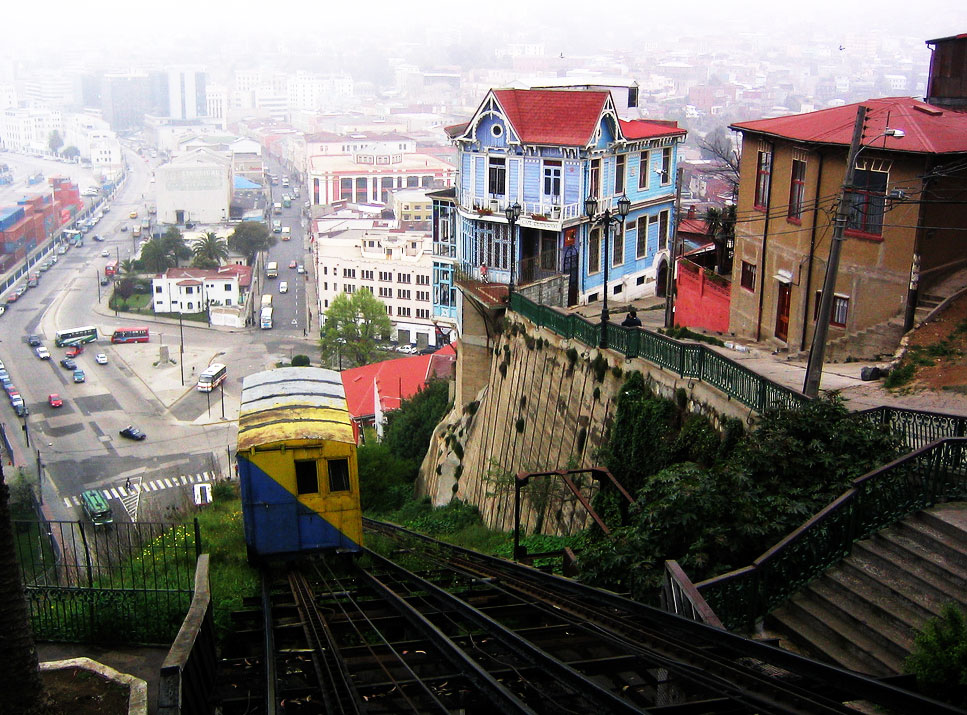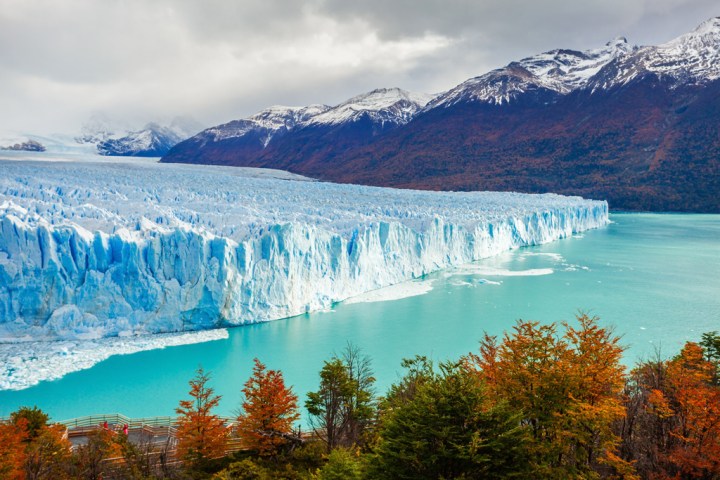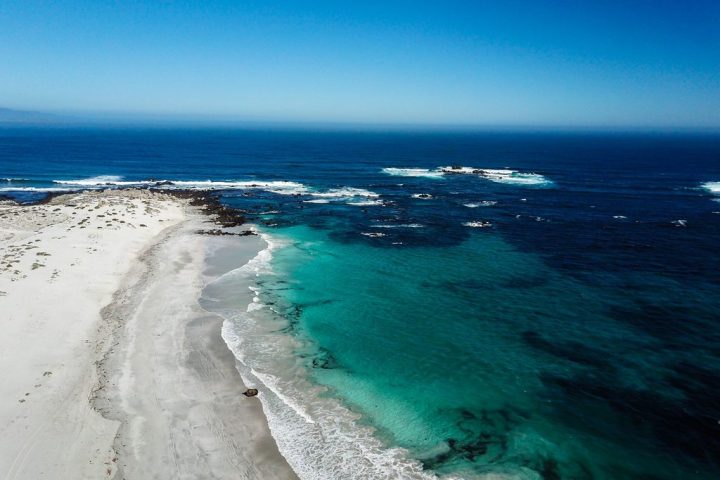The Hills of Valparaíso, Chile

Valparaíso is a walker’s city, so long as those walkers are willing to test their legs and lungs on its steep staircases and narrow alleyways—though they may prefer to use the surviving ascensores (funiculars) whenever possible. The following details the main hill neighborhoods from west to east (unofficial estimates put the total number of hills at about 45).
While the most prominent landmarks are mentioned here, there is much more to see, as the city’s typical constructions, with calamina (corrugated iron) siding and unexpected architectural flourishes, seemingly occupy every square inch of declivitous lots that would be considered unbuildable almost anywhere else. There’s a surprise around every corner, but the most famous feature is poet Pablo Neruda’s La Sebastiana home on Cerro Bellavista.
A good way to see the hills, and other neighborhoods, is through The Day Tour, a portal for several foreign and local tour guides.
Cerro Artillería
At the base of Cerro Artillería, Plaza Aduana (also known as Plaza Wheelwright) is the site of the former Aduana de Valparaíso (Customs House, 1854), a national monument since superseded by a newer building on Plaza Sotomayor.
From Plaza Aduana, one of the most popular tourist funiculars, the Ascensor Artillería carries passengers 50 meters above the port to Cerro Playa Ancha, with panoramic views from Paseo 21 de Mayo, a harbor-view terrace that’s home to the Museo Marítimo Nacional (1893). Ascensor Artillería extends for 175 meters with a 30-degree gradient. It dates from 1894.
Cerro Santo Domingo
Several blocks north of Plaza Sotomayor, at the base of Cerro Santo Domingo, Plaza Echaurren is the likely spot of the Spanish conquistador Juan de Saavedra’s 1536 landing. Almost immediately west, overlooking the Plaza Matriz, the Iglesia la Matriz del Salvador (1842) is one of several successors to the original 16th-century chapel. Designed by parish priest José Antonio Riobó, the basilicastyle construction is a national historical monument and the heart of Valparaíso’s oldest barrio; the neighborhood has a reputation for petty crime, but Sunday mornings are safe enough, as the faithful gather for Mass and most delinquents are sleeping off their Saturday night debaucheries.
Cerro Cordillera
From the top of Calle Hurtado, midway between Plaza Echaurren and Plaza Sotomayor, the funicular from 1887, Ascensor Cordillera, climbs to Plaza Eleuterio Ramírez, a short stroll from the Museo del Mar Lord Cochrane, which occupies a colonial-style house dating from 1841. This was also the site of Chile’s first astronomical observatory.
Cerro Alegre
This picturesque neighborhood served as a backdrop for a Chilean TV soap opera some years ago. It’s one of the best walking areas in the hills, easily linking up to Cerro Concepción and its namesake ascensor (funicular). From the Plaza de Justicia, immediately behind Plaza Sotomayor and the Primera Zona Naval, Ascensor El Peral (1902) is the access point to Cerro Alegre. (The entrance to the ascensor is nearly hidden, but can found by a conspicuous sign.) Dating from 1902, Ascensor El Peral climbs 52 meters at a 48-degree gradient.
From El Peral’s upper exit, Paseo Yugoeslavo leads directly to the Palacio Baburizza, a former mansion undergoing a lengthy rehab as the city’s Museo de Bellas Artes (Fine Arts Museum). Almost directly south, toward Cerro Concepción, the passageway steps known as Pasaje Bavestrello pass between separate wings of an apartment building, a nearly perfect integration of public and private space; on occasion, locals project movies onto the apartment walls. Calle Urriola marks the border between Cerro Alegre and Cerro Concepción.
Cerro Concepción
Dating from 1883, the city’s first funicular, Ascensor Concepción is also one of the most popular, climbing 69 meters at a 45-degree gradient from an inconspicuous entrance at the upper end of Carreño, just off Prat, to Paseo Gervasoni, home to a popular hillside restaurant and the starting point for walking tours of Concepción and Cerro Alegre. Its lower station entrance is opposite the Reloj Turri clock tower, from which it takes its popular name, Ascensor Turri.
Among the sights in this zona típica (designated historic area) are the Museo El Mirador de Lukas, memorializing cartoonist and caricaturist Renzo Pecchenino; Chile’s second Protestant church, dating from 1858, the Iglesia Anglicana San Pablo (Pilcomayo 566; classical organ concerts take place every Sunday at 12:30 p.m.); and the 1897 Gothic-style Iglesia Luterana (Beethoven and Abtao). Paseo Atkinson and Paseo Dimalow are typical hillside promenades, the latter linking with Ascensor Reina Victoria, an easy route to or from Plaza Aníbal Pinto.
One of the city’s most entertaining funiculars, Ascensor Reina Victoria (1902) climbs 40 meters of rails at a 57-degree gradient in cars holding only seven passengers. Reached from Plaza Aníbal Pinto via Cumming and Quebrada Elías, it has its upper station at Paseo Dimalow, another good starting point for walking tours of Cerro Concepción and Cerro Alegre.
Cerro Panteón
Reached by a series of steep streets and staircases, but no ascensores (funiculars), Cerro Panteón is home to three ridgetop cemeteries, of which the most interesting is the Cementerio de Disidentes, where non-Catholic immigrants found their final resting place. Immediately east is Parque Cultural Ex-Cárcel (Avenida Castro s/n, tel. 032/2258567) site of the former city prison, which now includes spacious gardens, a recycled cellblock with space for artisans, and new cultural center which hosts rotating art exhibitions.
Cerro Bellavista
At the upper end of Huito, marked by Ascensor Espíritu Santo, but also by streets and staircases, Cerro Bellavista is the site of the Museo al Cielo Abierto (Open Air Museum), a series of mostly abstract murals in strategic sites by more than a dozen well-known Chilean artists, including Roberto Matta, Nemesio Antúnez, and Roser Bru. Espíritu Santo is presently closed, and some of the murals have deteriorated with the weather.
Cerro Bellavista is also the focus of city renovation efforts by the Fundación Valparaíso (Héctor Calvo 205, tel. 032/2593156), which has renovated an abandoned and dilapidated house into its “campus.” Families in several historical houses here have taken advantage of the foundation’s technical and financial assistance to restore the facades of their homes.
On Bellavista’s uppermost reaches, poet Pablo Neruda bought La Sebastiana, one of his three outlandish houses (the other two are in Santiago and at Isla Negra, south of Valparaíso). Like the others, La Sebastiana is open to the public.
Dating from 1911, Ascensor Espíritu Santo is officially known as Ascensor del Cerro Bellavista; it climbs 66 meters, at a gradient of nearly 45 degrees, to its upper terminus at Paseo Rudolph. As of press time, Espíritu Santo was not operating, but it was due to undergo renovation and should reopen before the next edition of Moon Chile.
Cerro Barón
One of Valparaíso’s more easterly neighborhoods, Cerro Barón is home to one of its most conspicuous landmarks: For arriving vessels, the towering Iglesia San Francisco (Blanco Viel and Zañartu), a national historical monument dating from 1845, was their first glimpse of the city (Valparaíso’s historical nickname “Pancho,” a diminutive of Francisco, derives from the church). The imposing Universidad Técnica Federico Santa María (1931) overlooks Avenida España from Cerro Los Placeres.
From the Feria Persa Barón, a working-class flea market at the north end of Avenida Argentina, the Ascensor Barón (1906; the city’s first electric funicular) climbs to the Mirador Diego Portales, a scenic overlook that’s the best starting point for exploring the neighborhood. It ascends a gradient of nearly 60 degrees over its 98-meter length. The Barón has been closed, but should reopen soon.
Start planning your adventure.
Snow-covered mountains, bustling cities, temperate rainforests, and coastal wineries: get to know this country of contrasts with Moon Chile.
By clicking ‘Sign Up,’ I acknowledge that I have read and agree to Hachette Book Group’s Privacy Policy and Terms of Use
What to read next:



